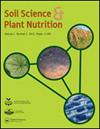Investigation of iron-reducing and iron-oxidizing bacterial communities in the rice rhizosphere of iron-toxic paddy field: a case study in Burkina Faso, West Africa
IF 1.8
4区 农林科学
Q3 ENVIRONMENTAL SCIENCES
引用次数: 0
Abstract
ABSTRACTIron (Fe) toxicity in rice is one of the serious problems in some paddy fields in West African areas. Microbial community structures involved in the redox cycle of Fe have not been revealed in the Fe-toxic paddy fields. The present study investigated the bacterial community structure and the abundance of Gallionellaceae, Geobacteraceae, and Anaeromyxobacteraceae, as the representative indicator bacteria of Fe oxidizers and reducers, in the bulk and rhizosphere soils and rice roots of a Fe-toxic paddy field in Burkina Faso (BF)in 2017–2019. Thosein a paddy field in Anjo, Japan (AN) were also analyzed for comparison. The amplicon sequencing analysis revealed that the BF rhizosphere soil was characterized by typical anaerobic bacterial groups like Firmicutes and Deltaproteobacteria, including several potential Fe reducers. The relative abundance of Gallionellaceae, lithotrophic Fe oxidizers, in the BF rice roots was significantly lower than that in the AN rice roots. Quantitative PCR analysis showed that the ratios of Gallionellaceae to Geobacteraceae and to Anaeromyxobacteraceae were higher in the rice roots than in the soils irrespective of the fields. However, the ratios of Gallionellaceae to Geobacteraceae were lower in the BF soils and roots than in the AN soils and roots. The ratios of Gallionellaceae to Anaeromyxobacteraceae in the BF soils were also lower than those in the AN soils. These findings indicated the relative predominance of Geobacter- and Anaeromyxobacter-related Fe reducers over Gallionellaceae-related Fe oxidizers in the rice rhizosphere of the BF field, corresponding well to the circumstances of Fe-toxic soil: higher Fe(II) amounts in the soil. Since Fe(II)-oxidizing activity at rice roots is an important factor as a primary defense system against Fe(II) in the soil solution, the ratios of Gallionellaceae to Geobacteraceae and to Anaeromyxobacteraceae may serve as an indicator of potential Fe(II)-oxidizing activity of rice rhizosphere. Further studies focusing on the activity of Fe oxidizers and Fe reducers at rice roots under effective cultivation practices and in various types of Fe-toxic paddy fields will help to promote a better understanding of the Fe-toxic soil circumstances and to establish sustainable rice cultivation in the Fe-toxic soils.KEYWORDS: Iron-oxidizing bacteriairon-reducing bacteriairon toxicitypaddy fieldrhizosphere AcknowledgmentsWe thank Kojima H. of Nagoya University for the measurement of Fed, Feo, and CEC, and Bagayogo A., Zougrana S., and Kiemde S. of the Institute of Environment and Agricultural Research for their help of the sampling and experiments in Burkina Faso.Disclosure statementNo potential conflict of interest was reported by the authors.Supplemental dataSupplemental data for this article can be accessed online at https://doi.org/10.1080/00380768.2023.2259426.Additional informationFundingThe present study was supported by the Grant-in-Aid from the JSPS KAKENHI [17H04619, 18K05372, and 21K05326] and the research grant from the Institute for Fermentation, Osaka [G-2015-1-012 and G-2021-1-004].铁中毒稻田水稻根际铁还原和铁氧化细菌群落调查:以西非布基纳法索为例
摘要:水稻铁离子(Fe)中毒是西非地区一些稻田存在的严重问题之一。在铁中毒稻田中,参与铁氧化还原循环的微生物群落结构尚未发现。研究了2017-2019年布基纳法索某铁中毒稻田块状土壤、根际土壤和水稻根系中Gallionellaceae、Geobacteraceae和Anaeromyxobacteraceae作为铁氧化还原剂和铁氧化还原剂代表性指示菌的细菌群落结构和丰度。并对日本安州某水田进行了比较分析。扩增子测序结果表明,BF根际土壤存在厚壁菌门和三角洲变形菌门等典型厌氧菌群,包括几种潜在的铁还原菌。富营养化铁氧化剂Gallionellaceae在富营养化水稻根系中的相对丰度显著低于氮化水稻根系。定量PCR分析表明,无论在何种田地,水稻根系中Gallionellaceae与Geobacteraceae和Anaeromyxobacteraceae的比例都高于土壤中。然而,在BF土壤和根系中Gallionellaceae与Geobacteraceae的比例低于AN土壤和根系。BF土壤中Gallionellaceae与厌氧菌科的比例也低于AN土壤。这些结果表明,在BF田的水稻根际,与地杆菌和厌氧杆菌相关的铁还原剂相对于与galgalellaceae相关的铁氧化剂相对优势,这与铁毒性土壤的情况相吻合:土壤中铁(II)含量较高。由于水稻根系的铁(II)氧化活性是土壤溶液中铁(II)的主要防御系统,因此Gallionellaceae与Geobacteraceae和Anaeromyxobacteraceae的比例可以作为水稻根际铁(II)氧化活性的潜在指标。进一步研究有效耕作方式和不同类型铁中毒稻田中水稻根系中铁氧化剂和铁还原剂的活性,将有助于更好地了解铁中毒土壤环境,并在铁中毒土壤中建立可持续的水稻种植。我们感谢名古屋大学的Kojima H.对Fed、Feo和CEC的测量,以及环境与农业研究所的Bagayogo A.、Zougrana S.和Kiemde S.对布基纳法索采样和实验的帮助。披露声明作者未报告潜在的利益冲突。本研究由JSPS KAKENHI [17H04619, 18K05372和21K05326]和大阪发酵研究所[G-2015-1-012和G-2021-1-004]的研究资助资助。
本文章由计算机程序翻译,如有差异,请以英文原文为准。
求助全文
约1分钟内获得全文
求助全文
来源期刊

Soil Science and Plant Nutrition
农林科学-农艺学
CiteScore
4.80
自引率
15.00%
发文量
56
审稿时长
18-36 weeks
期刊介绍:
Soil Science and Plant Nutrition is the official English journal of the Japanese Society of Soil Science and Plant Nutrition (JSSSPN), and publishes original research and reviews in soil physics, chemistry and mineralogy; soil biology; plant nutrition; soil genesis, classification and survey; soil fertility; fertilizers and soil amendments; environment; socio cultural soil science. The Journal publishes full length papers, short papers, and reviews.
 求助内容:
求助内容: 应助结果提醒方式:
应助结果提醒方式:


